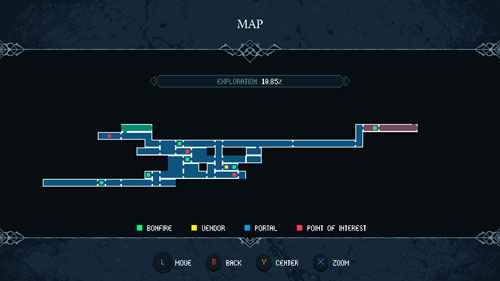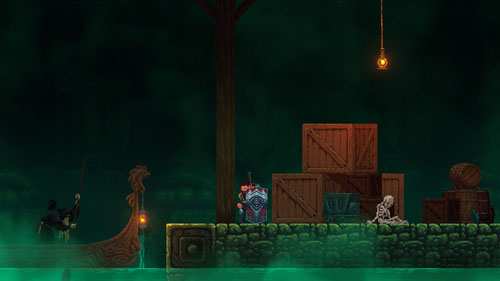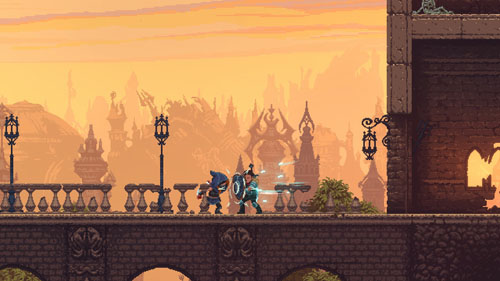A game by Mantra and Sinergia Games for PC and Switch, originally released in 2023.
Elderand is a metroidvania starring a nameless hunter on a quest to stop a zealous cult and its power-mad ruler. Soon after you embark on your journey, you find yourself shipwrecked on a strange shore with nothing but your hunter’s garb. Nearby, you find a sword that gives you a way of dealing with the creatures that lurk all around you… but you’ll need to grow your strength and find more powerful weapons and equipment if you hope to overcome the darkness that has infested every corner of this terrible land.Your sword grants you a 3-hit combo, but you must stand still to swing it. You can perform a single strike while ducking or jumping, and you have a 2x jump with only slightly variable height. You also have a forward dash and a backstep for quickly closing ground or dodging enemy attacks. As you explore, you discover subweapons in the form of daggers and axes, which work similarly to those in the Castlevania series. By pressing UP+ATTACK, you can toss knives in a straight line or lob axes in an arc, and later you find throwable bombs as well. You also gain access to a bow and arrows, allowing you to strike enemies at a distance, although arrows and subweapons are in limited supply and only appear as random drops from broken objects.
Swapping between the sword and bow works with a button press, but there are loads of other weapons that can be equipped, including strong but slow axes, fast twin daggers, whips, and spears that can summon magical projectiles that draw from a secondary magic meter. You can also equip armor to increase your defense, two rings that offer passive buffs, potions for quick healing or MP restoration, and a shield… although the shield only works if you’re carrying a 1-handed weapon. Some items grant secondary abilities as well, such as the ability to cause continuous poison damage, the ability to slash while dashing, and the ability to drop spinning sawblades when you perform a backstep, causing heavy damage to enemies that walk into them.
Unlike more traditional metroidvania titles, this game features a fully integrated levelling system, allowing you to increase various stats. Each time you level up, you can apply a single point to your vitality, strength, dexterity, or wisdom, and each of these stats can be raised to a level of 50. This allows you to develop a character that plays to your strengths, which impacts how you engage the game’s enemies and bosses.
Vitality increases your maximum health, allowing you to sustain more damage. Strength determines your attack power but also your maximum SP, which impacts how long you can hold up a shield to defend yourself. Dexterity gives you a higher critical hit chance and increases damage from bows, whips, and subweapons. Wisdom increases your maximum MP and magical attack strength.
You won’t gain enough levels to max out everything, and enemies can be tough, with most requiring several strikes to defeat. As such, your best bet is to focus on increasing one type of attack power, and possibly applying some points toward health to ensure that you can survive the game’s tougher encounters. But there’s nothing stopping you from spending every last point on raw strength or magic without levelling up your health in the slightest. If you go that route, you can turn yourself into the ultimate killing machine, so long as you use spells or a shield to protect yourself. This also makes the game a more technical experience as you need to be mindful of enemy attacks so that you can block and strike back effectively. Blindly hacking and slashing will see you falling quickly against most enemies, even early on.
One last tool at your disposal is the ability to increase the stats of your weapon, armor, and shield. After you’ve made a fair amount of progress, you’ll encounter a blacksmith who offers to upgrade your equipment, provided you have the proper crafting materials. These materials are acquired almost exclusively as enemy drops, so you’re encouraged to actively engage in combat to both level up and increase the efficacy of your equipment. A properly enhanced weapon can mean the difference between killing an enemy in two hits versus three, and it can help you work down the health bars of some tough bosses. Enemies respawn when you leave a room and reenter, so it’s possible to farm for enemy drops, but this is slow work as most drops are uncommon.
You frequently encounter cult members, and these are some of the darker moments in the game. Elsewhere, you’re mainly fighting monsters and other enemies typical of the dark gothic horror style, but cultists are a different story… For one thing, you can’t engage them in combat, despite the fact that your mission is to eventually destroy them. More importantly, these cultists are often seen worshipping giant skulls or preparing human sacrifices, and you can sometimes take part in these acts. There are several occasions where you can torture or kill someone to gain new items, with stat-boosting rings being the most common reward.
Campfires act as save points, and using them fully restores your health and magic meters. In a nice touch, each time you use a campfire, you’ll see a different animal cooking on the spit. Campfires also allow you to fast travel and reset your attributes, but these additional options aren’t unlocked until well into the game. Once fast travel is unlocked, you can warp between campfires, making late game item hunting easier, and also allowing you to search for hidden areas… which is important since nearly half of the game’s content is entirely optional, with multiple themed areas and boss encounters placed off the main path.
Early into the adventure, you’ll see platforms that require a double jump to reach, and what appear to be floating grapple points… but it’s entirely possible to complete the game without ever even finding the grappling hook. In fact, there is very little handholding, so you’re free to explore as you like, with several themed areas accessible with your starting abilities. You do need to gain a couple of new skills to finish the game, but if you march right into the final boss fight without fully exploring the world, you won’t get the best ending. You need to seek out the optional areas and fight the enemies and bosses within before you can face the true final boss and get the best ending.
A metroidvania map helps you to determine what areas remain to be explored, along with the locations of campfires, vendors, and other points of interest. You’ll need to look hard to ensure that you’ve explored thoroughly, and there are even some false walls that have hidden goodies for enterprising players, with exploration often rewarded with new equipment or permanent HP or MP increases. Since the game offers little direction, it’s also quite possible to stumble into areas with enemies that can kill you easily, so levelling up and getting better equipment are key to making progress.
Using potions can help you a bit, but you can only carry three of each type, so they’re better for getting you out of a jam than for regular use. Potions appear rarely as drops from broken objects, but you can purchase them from shopkeepers, along with subweapons, and some vendors offer equipment and materials as well.
Most enemies require a bit of strategy to defeat, as few of them go down in one hit. This means that you’ll need to make use of your backstep, shield, or magical abilities to avoid enemy strikes while closing ground to deliver damage of your own. Even after you’ve levelled up and found better equipment, you must remain mindful of enemy attacks and react accordingly if you hope to survive. There’s a good amount of enemy variety and behaviors – and often multiple enemy types attacking together – so you must frequently vary your strategy.
Enemies are often grotesque in nature, but boss creatures take this up another level. Early on, you really need to be mindful of how bosses telegraph their attacks, since most of them have a variety of abilities and are quite mobile. As you gain new equipment and level up, it’s possible to win some of the later encounters with simple brute force, but most fights will keep you on your toes, especially if you do the work to explore the tougher optional areas.
On the surface, the game appears to be a fairly straightforward metroidvania with above average creature designs, creepy yet lovely environments, and more than the usual amount of blood… along with plenty of cribbing from the genre favorite Castlevania series, and a soundtrack to match. The narrative is minimal and presented in a disconnected fashion, and aside from one recurring character interaction, most NPC interactions and lore pickups do little more than say “cult bad”. But players who take the time to fully explore the world will find hours of optional content and challenging enemies to satisfy their thirst for blood.
2D CRED
Elderand was developed by Mantra and Sinergia Games, and this was their first commercial release. Development was headed by Will Fernandes.
The game was published by Graffiti Games, which previously published Double Cross and The King’s Bird, among other games.





























0 comments:
Post a Comment